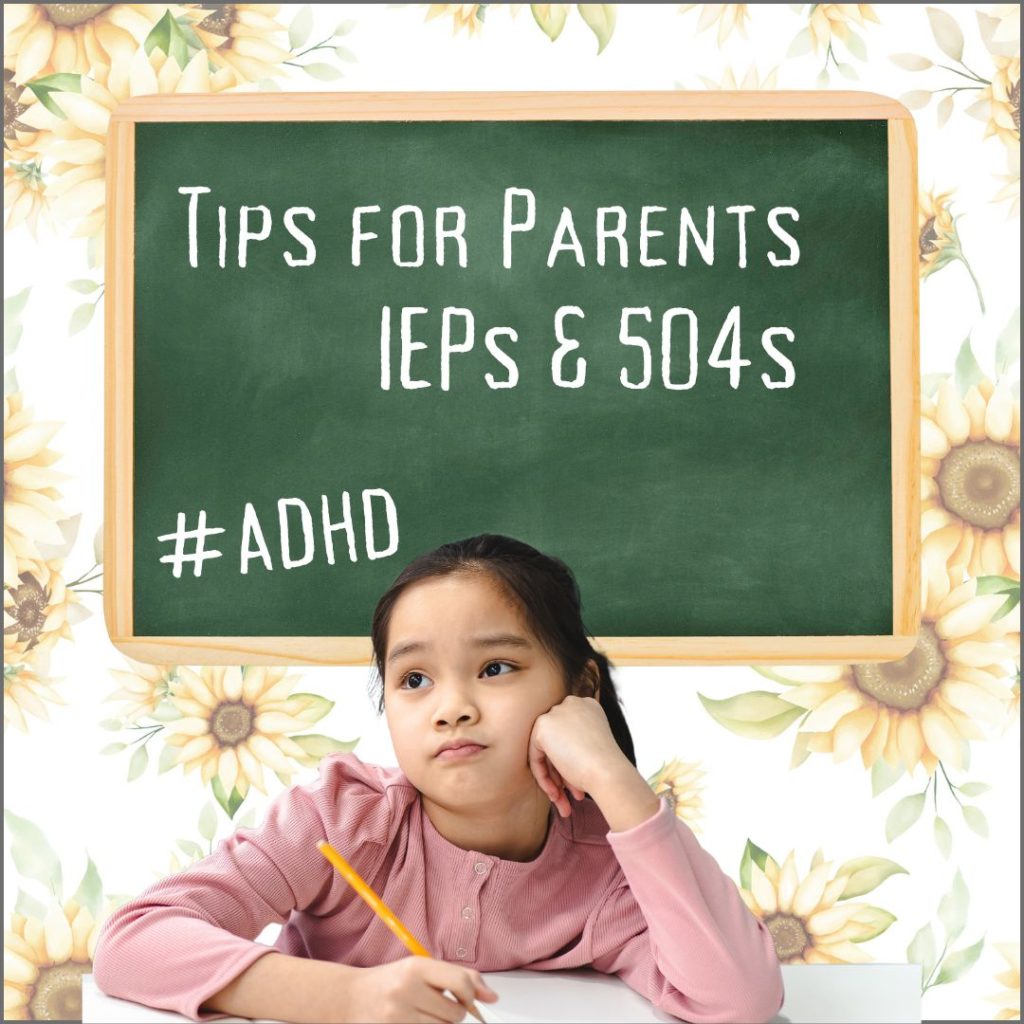ADHD Tips for Parents: IEPs and 504s
Last month, we started chatting about IEPs and 504 plans. If you missed that, you can check that blog out HERE.
Today let’s chat about some practical tips for parents of ADHD kids when it comes to IEP and 504 plans. Here are some tips for requesting, creating, and reviewing these plans with your schools and, when appropriate, with your child as well.


Requesting IEPs and 504s
The first step is the requesting. Here are a few tips for this part of the process.
- Know your rights. – Try to get at least somewhat familiar with the laws and rules and regulations that cover special education services – this would include the IDEA (Individuals with Disabilities Education Act) for IEPs and the Rehabilityation Act regarding 504s.
- Put Everything In Writing. – Document everything. In writing. Put all requests in writing. If you have a phone call, send a follow up email outlining what was discussed so that you have a record in writing. Much of the time schools are obligated by certain timelines so long as you put things in writing.
- Be As Specific As Possible. – when asking for a review, make sure you are as specific as possible about what struggles you are noticing and what things you think might be helpful. You are the expert of your child.
- Seek Help – There are professional IEP and parent advocates around if you can access one. If not, you can request to meet with the school provided parent advocate. You can and should talk to other parents of kids with similar diagnosis who have already gone through the process for tips. Your coach or therapist may also be able to assist or offer tips and information. Getting notes and reports from your child’s medical providers will help as well. The more people on your child’s team the better.
- Don’t Assume The School Will Tell You Everything You Should Know – Sadly, the school districts often are not as helpful as they could be. Depending on your school district, you may be given all the information, but it may be hidden or difficult to find. They may not offer solutions even if they have them. They may actively resist anything that will cost the district additional money. While you should assume good will, also don’t take everything at face value.
Creating IEPs and 504s
Once the school and the Team decide that yes, your child qualifes for on eof these plans, what comes next? Here are a few tips for this stage of the process.
- Get As Much Documentation As Possible – knowledge is power. The more information you have, the better you can advocate for your child. Collect info from doctors, teachers, therapists, co-parents, babysitters, anyone who knows your child well either personally or professionally. Include assessments, reviews, summaries, teacher observations, test scores, etc. All of this will help form the plan.
- Identify Strengths As Well As Needs – sometimes we focus on the areas our children are struggling in and forget to also identify their strengths. This is important to keep in mind as your child’s strengths not only should be celebrated, but also their strengths can be leveraged to help them succeed.
- Set Clear And Measurable Goals – I’ll be discussing this more next month, but the goals in your child’s plans should be very clear and measureable. There has to be a way to measure your child’s process toward their goals.
- Involve Your Child – Whenever possible, depending on age and maturity and other factors, involve your child in the creation of the plan. Once they hit a certain age, the school district generally advises the child be involved, but you can have them involved at any stage. Sometimes even when very young, your child might have insights into what they are struggling with and may have ideas for what might help.
- Keep Open Communication With Teachers – These are the people who are really implementing the plan created. You’ll want to keep open lines of communication with your teachers and other professionals.


Reviewing IEPs and 504s
An important part of this process is the regular reviewing of the plan and the progress made towards the stated goals. Here are a few tips for this stage!
- Attend Annual Reviews – by law, these types of plans require an official review with the entire team at least annually. Parents are always invited, but don’t always attend. It’s best to attend all annual reviews whenever possible. This is where most changes can be made the most easily if needed.
- Review Regularly – In addition to offical annual reviews, do your own review regularly. Monthly or Quarterly – review on your own, ask teachers for progress reports, and check in with students to see how they feel things are going.
- Prepare Ahead Of Time – You will generally know when the annual reviews are being held. When possible, gather any additional documents or reports that you may need. Try to prepare your own questions ahead of time and write up and provide your own observations.
- Include Student Input When Possible – Again, when possible include your student in the Annual Review. This isn’t always possible due to age, maturity, or – when older – some teens just refuse. But whenever possible, include their input.
- Discuss Transition Plans If Needed – When doing your official annual reviews, you need to make sure to discuss transition plans any time your child will be going from one school to another, or – graduating from high school. You want your child to have the best chance at a smooth transition as possible.


 Don’t Delay Joy
Don’t Delay Joy
Kat Sweeney, MCLC

